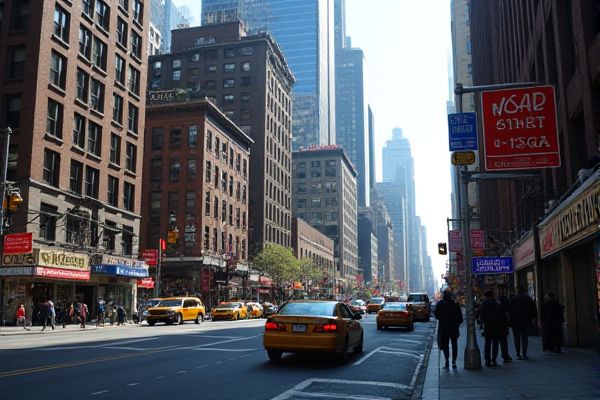
Transportation and commuting in New York: Extensive subway network. Iconic yellow taxis. Biking-friendly infrastructure. Bus system accessibility. Commuter train options. Rideshare availability. Traffic congestion. Best apps for navigation. MetroCard payment system. Walkability in Manhattan.
Extensive subway network
The New York City Subway is a vast and complex rapid transit system serving the boroughs of Manhattan, Brooklyn, Queens, and the Bronx. It boasts 472 stations, 36 lines, and 28 services, making it one of the oldest, busiest, and largest subway systems in the world. Operating 24/7, it carries over 2 billion riders annually. For more detailed information, you can visit the New York City Subway page, which explores its extensive operations and significance in urban transit.
Iconic yellow taxis
The iconic yellow taxis in New York City, famously referred to as medallion taxis, are licensed by the New York City Taxi and Limousine Commission (TLC) and have the unique privilege of picking up passengers anywhere across the five boroughs. The yellow color was strategically adopted for its high visibility, with the official hue now specified as Dupont M6284 yellow or its equivalent. This distinct color not only enhances their visibility on the bustling streets but also helps distinguish medallion taxis from other for-hire vehicles. For more detailed information about medallion taxis, you can visit the Taxis of New York City page.
Biking-friendly infrastructure
New York City has extensively developed biking-friendly infrastructure, including over 1,375 miles of bike routes and more than 480 miles of protected bike lanes. The city has implemented a comprehensive network of greenways and bike share programs to enhance safety, accessibility, and convenience for cyclists across all five boroughs. For more detailed information, you can explore the [Bicyclists Program](https://www.nyc.gov/html/dot/html/bicyclists/bicyclists.shtml) provided by the New York City Department of Transportation.
Bus system accessibility
While the query specifically asks about New York, the provided sources primarily focus on the subway system. However, for context on bus system accessibility, NJ Transit's Access Link, though not in New York City, serves as a model: Access Link is a paratransit service designed for people with disabilities who cannot use local fixed-route bus or light rail systems, offering curb-to-curb transportation and complying with the Americans with Disabilities Act (ADA).
Commuter train options
New York City and its surrounding areas are served by several commuter train options, including NJ Transit lines such as the Northeast Corridor, North Jersey Coast Line, Raritan Valley Line, and others, which connect various parts of New Jersey to Penn Station New York, with transfers available at key junctions like Newark Penn Station and Secaucus Junction. Additionally, other networks like the Metro-North Railroad and the Port Authority Trans-Hudson (PATH) provide extensive commuter rail services connecting New York City to its northern suburbs and neighboring states. For more details, visit the NJ Transit website.
Rideshare availability
In New York, various rideshare services are available, including Uber, Lyft, Revel (an all-electric option), Arro for traditional taxis, and other specialized services like Empower, Snow Limo for large groups, and Luxy Ride for luxury rides. These services operate across New York City and extend to nearby airports and parts of New Jersey. For a comprehensive guide on navigating these options and understanding their nuances in New York, visit the Ride.Guru website.
Traffic congestion
New York City has been ranked the world's most congested city for the second year in a row, with motorists losing approximately 101 hours to traffic each year. The congestion is exacerbated by a high volume of businesses, a post-COVID hybrid work schedule, and the indefinite pause on the city's Congestion Pricing Plan, which was intended to alleviate traffic and generate revenue for mass transit improvements.
Best apps for navigation
For those navigating the bustling streets of New York City, a variety of apps can significantly ease the complexity of urban transit. Noteworthy tools include KickMap for offline access to subway maps and HopStop for detailed public transport guidance. Suburban commuters might prefer NYC Mate, while CabSense NYC assists in taxi hailing. For personalized car services, Uber remains a top choice, and Central Park NYC helps explorers make the most of their park visits. Additionally, the SmartAsset article highlights these apps along with other popular ones like Google Maps and Transit, known for offering real-time updates and multi-mode transportation planning. Key contenders for facilitating seamless city navigation also include Citymapper and MTA's Embark NYC, providing real-time service alerts and enhancing user experience across subways, buses, ferries, and bikes.
MetroCard payment system
The MetroCard is a magnetic stripe card integral to fare payment across New York City's subway, buses, and other connected transportation systems. Available options include pay-per-ride value or unlimited ride passes for durations of seven or thirty days. However, the card is poised to be phased out by 2025, as it will give way to the modernized OMNY Contactless Payment System, marking a significant transition in the city's transit fare collection methods.
Walkability in Manhattan
Manhattan boasts the highest average walkability score among the boroughs in New York City. Notably, the zip code 10280 near Battery Park holds the top walkability index score. Higher walkability in Manhattan correlates with increased physical activity, as residents in highly walkable neighborhoods engage in approximately 100 more minutes of physical activity per week compared to those in areas with lower walkability. For more detailed information, visit the Walkability Index Report.
